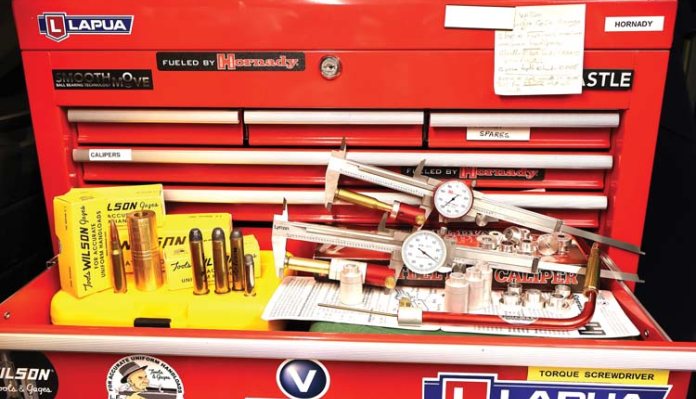Reloaders’ Gauge Guide
- Last updated: 12/03/2025

Reloading is a pretty precise process, and the more precise you are, the better your ammunition will be. There are numerous gauges you can buy to help check and even correct your ammunition, and it is definitely worth having a few on your reloading bench. Here is a small selection of the ones that I like to have close at hand.
The simplest of gauges
When you are making ammunition, it is always worth making up a dummy round without powder or a primer. You can then use this as a gauge when resetting your dies or checking whether your reloads are going to fit into a particular gun. Reloading dies can sometimes slip out of adjustment or might need disassembling for cleaning, and the dummy round makes resetting them much faster and easier.
Chamber minimum dimension gauges
These gauges mimic SAAMI minimum standard chamber dimensions, allowing you to check your reloads. You slip one of your complete rounds into the gauge, and if it fits smoothly, then your rounds will function in any rifle with a chamber built to SAAMI specifications. If it does not fit, then it may not have been sufficiently resized. If your rounds fit in the gauge but not in the gun’s chamber, this suggests that your chamber is particularly tight, and you might have to revisit your reloads in order for them to chamber correctly.
Headspace gauges
When cases are fired, they stretch, and resizing them ‘bumps’ the length back down. Being able to measure the changes in length is very useful. You can set the resizing die to bump the shoulder of the case just enough to ensure it chambers correctly while minimising the amount of stress that you put on the brass. This will extend the life of your cases.
To measure this dimension as accurately as possible, a gauge that measures the length from the case head to the bearing surface where the ammunition headspaces, i.e., the shoulder of the case, is the best option. A headspace comparator kit contains calibre-specific bushings that sit on the shoulder of the case. The correct bushing is fitted to the comparator, which is then attached to a calliper. You then measure the length of both fired and unfired cases to determine the difference and set your resizing die accordingly. This is a particularly useful gauge.
Callipers
Although technically not a gauge, having at least one set of callipers on the bench is a good idea. They have many uses, including checking cartridge overall lengths, bullet diameters, and brass thicknesses. Reloading data comes in both metric and imperial units, so a micrometre that reads both, or having two different tools (one metric and one imperial), is a good idea.
Bullet comparators and overall length gauges
A bullet comparator is a gauge that measures the cartridge length from the ogive of the bullet rather than the tip. This is considered more accurate and consistent, as measurements taken from the tip can vary due to tolerances in bullet lengths or damage to the bullet tip. The comparator attaches to a pair of callipers and uses calibre-specific, interchangeable inserts that engage with the ogive of the bullet to give more consistent and repeatable measurements. Taking measurements from the ogive of your bullets is a far more reliable way of measuring, setting, and comparing your cartridge lengths.
The overall length of your rounds will dictate the amount of ‘jump’ the bullet has to travel before it engages with the rifling, and this has been proven to have a significant effect on the performance of ammunition. Being able to measure, adjust, and set the amount of jump is particularly useful, and gauges that do this are another worthwhile investment. The Hornady O.A.L. Gauge, combined with a modified case of the appropriate calibre (sold separately), uses one of your bullets to engage the rifling and secures it in place so that you can then measure the precise cartridge overall length (COL) that touches the rifling. You then set your bullet seating die to produce ammunition that is shorter than this by the precise amount of bullet jump that you require.
When you combine the bullet comparator tool with the O.A.L. gauge, you get even better accuracy and consistency, and you can set up your bullet jump exactly the way you want it.
These particular tools are expensive and can take a bit of getting used to before you can use them properly and accurately, but they really do help you to get the best accuracy out of your ammunition.
Concentricity tools
These tools check the alignment of your seated bullets and can be used to correct them if necessary. Bullets that are not seated in proper alignment with the case mouth will enter the rifling at a skewed angle and need to be forced straight by the chamber pressure. This can have a detrimental effect on the bullet and also create inconsistencies between rounds. The concentricity tool holds a round so that it rotates against a probe attached to a gauge, which measures how far the bullet is out of alignment. A thumb turn is then used to push the bullet into alignment and reduce the amount of run-out. This is one tool that really does work, and ammunition that has been ‘corrected’ with it will certainly perform better than a batch that has not had concentricity addressed.
Conclusion
These are just a few of the gauges that are available to the reloader, and they all contribute to better and more consistent ammunition. What you buy is up to you, and while they can be expensive, they have all proven to be a worthwhile investment. GM
Contacts:
Hornady - Edgar Brothers -
www.edgarbrothers.com
Lee Precision – Henry Krank & Co. -
www.henrykrank.com
Wilson Products - Reloading Solutions Ltd -
www.reloadingsolutions.com